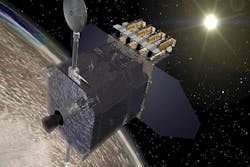IBM helped NASA fix one of its satellites using cutting-edge deep learning artificial intelligence (AI)
The Military & Aerospace Electronics take:
10 April 2019 -- That’s a question that NASA had to answer when it ran into problems with one of its crucial satellites. The satellite in question was the Solar Dynamics Observatory (SDO), which launched in 2010 with the important goal of studying the Sun and the effects of solar activity on Earth.
Unfortunately, one of the SDO’s three instruments, responsible for measuring ultraviolet light, stopped working due to a fault. It was deemed too costly to repair the $850 million satellite in space. As a result, NASA called in experts from IBM, SETI, Nimbix, Lockheed Martin, and its own Frontier Development Lab to see if they could solve the problem from Earth using cutting-edge artificial intelligence.
In the end, a joint venture on the part of the researchers was able to create a deep learning neural network which could predict the required data with greater than 97 percent accuracy.
John Keller, chief editor
Military & Aerospace Electronics
Ready to make a purchase? Search the Military & Aerospace Electronics Buyer's Guide for companies, new products, press releases, and videos
